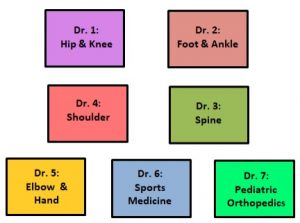 When we think of female physicians, we think of specialties such as pediatrics, obstetrics and gynecology, family practice and veterinary. Anyone with older parents may also add geriatric medicine to the list of the medical professions women choose to go into.
When we think of female physicians, we think of specialties such as pediatrics, obstetrics and gynecology, family practice and veterinary. Anyone with older parents may also add geriatric medicine to the list of the medical professions women choose to go into.
If you think about why women go into these professions you probably think back to the stereotypes. Women select medical specialties that align with their traditional domestic role of caring for children, the elderly, animals midwifery. But, after I took a nasty fall from my bicycle, I saw another reason why women gravitate towards certain specialties and stay away from others.
In my fall, I shattered my wrist but also damaged the right side of my torso. I complained right away about my shoulder but since it wasn’t broken or dislocated, all the attention went to my wrist. Eventually I began seeing a chiropractor about the rest of my torso. As I told her everything that hurt, she said “It’s all connected.”
My reply was, “Then why isn’t it being treated that way?”
She gave a sarcastic laugh and I knew what she meant.
A few months later when I began physical therapy for my wrist I told my physical therapist that my it was my shoulder that hurt and bothered me the most. Her reply was, “It’s all connected.”
I again replied, “Then why isn’t it being treated that way?”
She told me she was only authorized to treat my wrist, that’s how it works
As my wrist improved, my shoulder became the limiting factor in my recovery because “It’s all connected.”
I went back to my orthopedic surgeon who looked at my wrist and then my shoulder. I noticed he didn’t say, “It’s all connected.” He just sent me back to my primary care doctor for a new referral. Once I had my referral I called back to get a new appointment with my orthopedic surgeon. I was told he only does wrists and hands. I had to see a different doctor who does shoulders.
No. I want to see the orthopedic I’d been seeing for months, who knew my case.
No you can’t see him. He doesn’t treat shoulders. I had to make an appointment with the shoulder guy.
 Frustrated, I went on the practice’s website and was shocked by how the doctors were broken down and fragmented by body parts.
Frustrated, I went on the practice’s website and was shocked by how the doctors were broken down and fragmented by body parts.
“It’s all connected,” didn’t apply to how a patient was treated.
Through my own professional work, I knew that fragmenting the whole into pieces and parts is classic male thinking. I looked up the gender divide for medical specialties. Orthopedic surgeons are 95% male and 5% female.
I wasn’t surprised.
A few years earlier I had a colonoscopy and my female doctor and I discussed how we both were in very male-dominated professions. I remember laughing as she rolled her eyes as she talked about the men in her practice. Gastroenterology is only 16% female.
Women make up about 34% of the physicians but there is a significant gender divide within some specialties and the pay of those specialties.
Other male-dominated specialties are:
- Neurological Surgery 92% male
- Thoracic Surgery 94% male
- Urology 92% male
- Pulmonary Disease and Vascular Surgery 88% male
- Interventional Cardiology 92% male
Now before you cry out about gender biases and gender gap, let’s consider a different bias.
How do you think about the people who go into these male-dominated specialties? Do you think, “These are the specialties that the really smart guys go into. You have to be a genius to specialize in these.”
How do you think about family practice doctors?
Do you think of them as the people who barely got out of medical school and weren’t good enough for a specialty?
We are taught to think of people who are generalists as less intelligent. We think of people who have a narrow area of expertise as smarter. This kind of thinking dominates the male-dominated workplace.
But what do the pediatrician, the veterinarian, the geriatrician and the OB/Gyn all have in common?
They treat the whole body, not just a body part. (Yes guys, women think of our OB/Gyn as a “woman’s doctor” and we tell her everything that is going on with us physically and mentally.)
Women tend towards professions where we can work from the premise that, “It’s all connected.” We want to treat the body holistically, not fragment it into isolated pieces and parts.
Nursing is the same – it is caring for the whole patient.
Men and women have different perspectives. Men fragment to create individual pieces and parts so they can specialize and have a narrow field of expertise. Women connect the pieces and parts to understand how they work together and influence each other.
My own profession of construction is similar to medicine in how it fragments. To construct a building we have different trades – concrete, structural, plumbing, mechanical, roofing, electrical, insulation, drywall, finishes etc. The industry struggles to integrate all of these trades efficiently and effectively. That shouldn’t be a surprise since it is nearly 100% men who work on a construction site.
As the female project/construction manager, I had a female perspective. I focused on connecting and integrating all the project pieces and parts. I looked at my projects holistically. This why my projects always out-performed all of my male colleagues projects.
As women we have to understand that our ability to join all the pieces and parts together – to integrate and coordinate how they function as a whole – is our 21st century super power.
I would have loved it if I went into the emergency room and saw a female ER doctor who looked at all of my injuries and developed a holistic, integrated approach to my recovery. That holistic approach should have then been communicated to me and my family practitioner so she could take over and manage my recovery.
For women in all industries creating an integrated and holistic approach is our greatest opportunity. It is why we should be always be thinking “It’s all connected.”
Empowered Women Go Beyond Current Practices and Think Holistically
Find this article helpful?
Sign up to receive more

